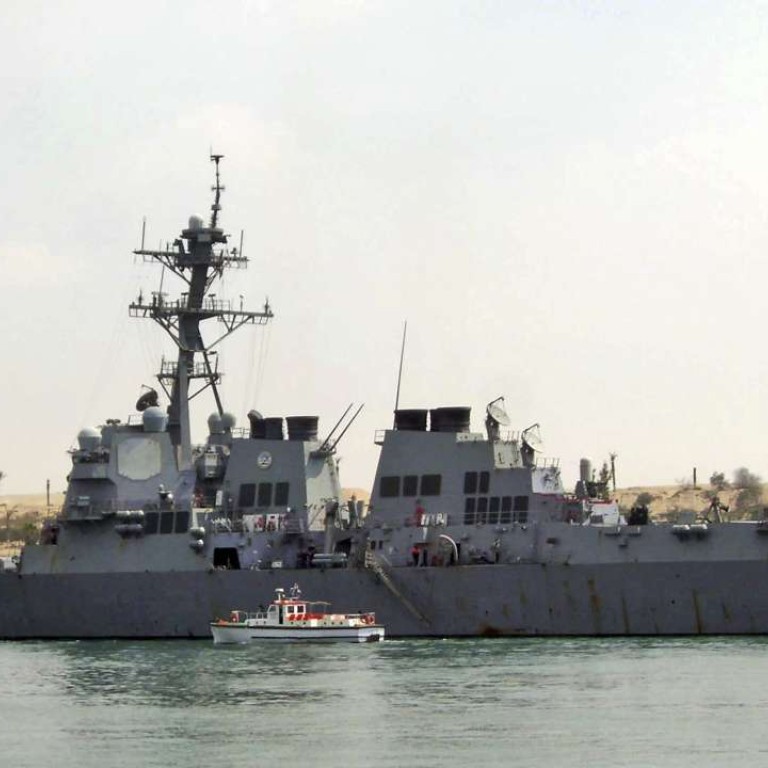
US warship is attacked with missiles fired from rebel territory in Yemen
Iran-backed Houthis may be to blame for failed assault, as Washington reviews support for Saudi-led coalition fighting rebels
A US Navy destroyer was targeted in a failed missile attack from territory in Yemen controlled by Iran-aligned Houthi rebels, a US military spokesman said, although neither of the two missiles hit the ship.
The attempted strike on the USS Mason came just a week after a United Arab Emirates vessel came under attack from Houthis and suggests growing risks to the US military from Yemen’s conflict.
The US government, which has become increasingly vocal about civilian casualties in the war, this weekend announced a review of its support to a Saudi Arabia-led coalition battling the Houthis after a strike on mourners in the capital Sanaa that killed up to 140 people.
The failed missile attack on the USS Mason began around 7pm local time, when the ship detected two inbound missiles over a one-hour period in the Red Sea off Yemen’s coast, the US military said.
“Both missiles impacted the water before reaching the ship,” Pentagon spokesman Captain Jeff Davis said. “There were no injuries to our sailors and no damage to the ship.”
Saudi Arabia and the United States blame Shi’ite Iran for supplying weapons to the Houthis. Tehran views the Houthis, who are from a Shi’ite sect, as the legitimate authority in Yemen but denies it supplies them with weapons.
A US defence official, speaking on condition of anonymity, said the first missile triggered counter-measures from the USS Mason. It was not immediately clear whether those defences may have helped prevent a direct hit on the ship.
The USS Mason did not return fire, the official said, adding that the incident took place just north of the Bab al-Mandab strait off Yemen’s southern coast.
Last week’s attack on the UAE vessel also took place around the Bab al-Mandab strait, in what the UAE branded an “act of terrorism.”
In 2013, more than 3.4 million barrels of oil passed through the 20 km-wide Bab al-Mandab each day, the US Energy Information Administration says.
It was unclear what actions the US military might take, but Davis stressed a commitment to defend freedom of navigation and protect US forces.

The attack also came the same day that Yemen’s powerful former president, Ali Abdullah Saleh, a key Houthi ally, called for an escalation of attacks against Saudi Arabia, demanding “battle readiness at the fronts on the (Saudi) border”.
An estimated 10,000 people have been killed in Yemen’s war. The United Nations blames Saudi-led coalition strikes for 60 per cent of some 3,800 civilian deaths since they began in March 2015.
Meanwhile, a ballistic missile launched from Yemen apparently targeted a Saudi air base near the Muslim holy city of Mecca, Saudi and rebel media reported — the deepest strike yet into the kingdom by Shiite rebels and their allies.
Saudi state television aired a brief clip of what appeared to be a projectile that was said to have landed in Taif in the ballistic missile attack. The video shows the flash of an explosion, followed by images of emergency vehicles. Taif is home to Saudi Arabia’s King Fahad Air Base, which hosts US military personnel training the kingdom’s armed forces.
The Saudi military said the missile fired late Saturday night caused no damage. The US military’s Central Command, which oversees troops in the Middle East, did not immediately respond to a request for comment.
Al-Masirah, a satellite news channel run by Houthis, identified the missile as a local variant of a Soviet-era Scud missile. It said the Volcano-1 missile targeted the air base.
The Houthis have fired a series of ballistic missiles in Saudi Arabia since a kingdom-led coalition of Arab countries has launched an offensive against them in Yemen in March 2015. Most of those ballistic missiles have hit areas far closer to Saudi Arabia’s border with Yemen, like an attack Friday night that targeted the southwestern city of Khamis Mushait.
In the Taif attack, however, the missile struck a target more than 520 kilometers from the border. Taif also is just outside of Mecca, which is home to the cube-shaped Kaaba, toward which all of the world’s Muslims pray.

